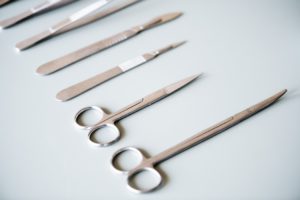 Passivation of stainless steel is the treatment of metal’s surface with an acid solution to make the surface corrosion resistant. Citric acid passivation and nitric acid passivation are the two methods used to treat the metal. The acid solution acts to remove any free iron from the metal’s surface before that iron can react to water and oxygen in the air, causing rust oxidation. Passivation is a post-fabrication method to maximize the natural corrosion resistance of other alloys found in stainless steel. Thus, once the metal’s surface is treated, other alloys, like chromium or nickel, react with oxygen to form an oxide layer that protects the underlying metal surface from corrosion.
Passivation of stainless steel is the treatment of metal’s surface with an acid solution to make the surface corrosion resistant. Citric acid passivation and nitric acid passivation are the two methods used to treat the metal. The acid solution acts to remove any free iron from the metal’s surface before that iron can react to water and oxygen in the air, causing rust oxidation. Passivation is a post-fabrication method to maximize the natural corrosion resistance of other alloys found in stainless steel. Thus, once the metal’s surface is treated, other alloys, like chromium or nickel, react with oxygen to form an oxide layer that protects the underlying metal surface from corrosion.
If metals are not passivated, pitting and cavity corrosion can occur rapidly, reducing its strength, thickness, and structural integrity. Corrosion can occur simply through contact, too, when iron oxide deposits from a rusting piece of metal touches non-rusting stainless steel it will spread beyond the point of contact. Corrosion can also happen in any crevice or confined space on a metal’s surface, such as the gaps amongst a nut and a bolt.
Nitric acid was long used as the only method to passivate stainless steel before studies showed that citric acid provided a safer, more effective means with many advantages. Citric acid is organic, bio-friendly, and safe to use. It is derived from citrus fruits—oranges, lemons, limes, etc.—and it offers excellent results at considerably lower costs. Not only is 99% of the citric acid sold in the U.S. consumed, as a food and beverage product, it is also used in cleaners and disinfectants.
Passivation of stainless steel with citric acid was developed in the beverage industry in Germany years ago to rid the aftertaste of iron in the beverages from the stainless steel containers where nitric acid could not provide the degree of passivation necessary. Correctly formulated, citric acid passivation produced excellent results in nearly all stainless steel products. It is used for cleaning, brightening and passivation of other metals as well. Some industries using citric acid include fasteners, medical devices, semiconductors, automotive, defense and aerospace.
Safety and reduced costs are the biggest benefits of citric acid passivation. For starters, it is safe for employees to use or around those who may be exposed to it. There is no need to invest in costly overhead for special handling equipment and safety devices for employees. Citric acid does not corrode other equipment and structures, either, like nitric acid. There is no hazardous waste removal, or the costs and regulatory oversight associated with it, and citric acids is stored as a non-hazardous material. Finally, nitrogen oxide vapors (NOx) emitted from nitric oxide are a culprit in the formation of smog and acid rain, as well as in affecting the tropospheric ozone layer. Obviously, citric acid does not produce smog and is not harmful to the atmosphere.
Another cost-saving benefit of citric acid passivation is its efficiency in removing free iron from the metal’s surface with a much lower solution concentration than nitric acid. A citric acid solution is typically in the 4 to 10% range by weight. Passivation baths generally take less time than those for nitric acid, too, with production speeds up to five times faster in some instances.
Passivation is a necessary process to maximize the natural corrosion resistance of stainless steel. Citric acid passivation of stainless steel not only provides a safe work environment for employees but is a versatile, effective, easy to use, environmentally safe method, with less maintenance and lower costs.
To learn more about this unique service RPA offers please visit our services page. We also offer samples free of charge.
